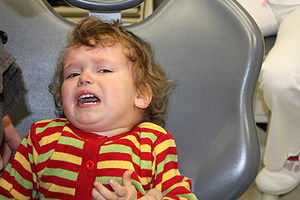 Image via Wikipedia
Image via WikipediaNews for sedation Dentistry
Sleep Dentistry An Option For Those With Dental Phobias
A trip to the dentist has become more soothing for the anxious patient with the advent of a process known as sleep dentistry.The term “sleep dentistry” (also known as “sedation dentistry”) is a bit of a misnomer in that the patient isn’t technically asleep. Instead, the patient is placed into a relaxed state with the use of strong sedatives, allowing the patient to experience the dental procedure as if in a dream. Local anesthetics also are in the mix to make the session pain-free, although the patient will experience the usual discomfort once the anesthetic wears off. This treatment came about as a way to entice those with a fear of a visit to the dentist to put those fears aside to receive dental treatment that is sometimes a necessity. Some dental procedures can be invasive and painful, too much so for some patients, so the prospect of being able to “sleep” through the procedure helps some patients to overcome their fears.via The Daily Planet Dispatch
Sedation Dentistry is a technique used in dentistry in which the use of drugs produces a state of depression of the central nervous system enabling treatment to be carried out, but during which communication can be maintained and the modification of the patient's state of mind is such that the patient will respond to command through out the period of sedation. This is according to General Dental council.
In the dental clinic,there are children and adults who are very apprehensive about dental treatment.Some could be managed by discussing their fears and reassurance in the part of the dentist which sometimes works.But there are cases where no amount of reassurance works.A child patient whom you can not entice to seat on the dental chair. A child who seats on the chair but when the dentist tries to start the treatment, he starts kicking and thrashing.A man or woman who starts to sweat , hyperventilate,tremble and cower at the sight of the needle.It can sometimes be funny,sometimes irritating if you see it in adults but their fears are to them true.The anxiety felt is so strong that the tooth ache they are feeling is disregarded.This fear prevents them from seeking dental treatment to the detriment of their oral health.Then it is time to consider sedation dentistry.
Routes of sedation dentistry
1. Oral Premedication- normally using benzodiazipines
2. Inhalation sedation - using nitrous oxide and oxygen.There should be correct mixture of both gasses using a specific equipment.The most common equipment used is the Quantiflex system.
3. Intravenous Sedation- uses one of the following drugs
a. Earlier drugs used were pentobarbitone,pethidine, hyoscine, methohexitone and benzodiazipine drugs
b. Midazolam which have superseded the use of diazepam.
4. Hypnotherapy- uses hypnosis
5. Transmucosal sedation - usually intranasal or through the nose
Sedation Dentistry is not for patients who have:
1. Sever respiratory diseases
2. Neurological disease like multiple sclerosis
3. Deafness
4. Sever mental or physical impairment
5. Nasal obstruction like nasal polyps,common colds
6. Patients intolerant to mask if contemplating the used of inhalation sedation
Intravenous sedation is contraindicated for:
1. Patients taking oral benzodiazepines because they will be more difficult to sedate.
2. It is not suitable for young children under 10 years old.
What to expect with conscious sedation dentistry,take note that these are temporary only
1. Tingling sensation in the fingers,toes,lips and tongue
2. Tinnitus or ringing noise in the ear.
3. Lethargy - delayed or slowed reaction to requests
4. Mild intoxication
5. Some patients may hallucinate under sedation.
6. Normally controlled emotions may be released with the use of intravenous sedation.
7. Patients are not discharged until they have fully recovered which is from 1 hour to 1 hour 30 minutes.
Sedation Dentistry in conjunction with the use of local anesthesia is a means to help very anxious patients have much needed dental treatments, therefor improving their quality of life.
linux web hosting


I like this topic. I want know some helpful things from this side. It is one of the best post from other. It is a useful and charming post.It is extremely helpful for me
ReplyDeleteDentist Wayland